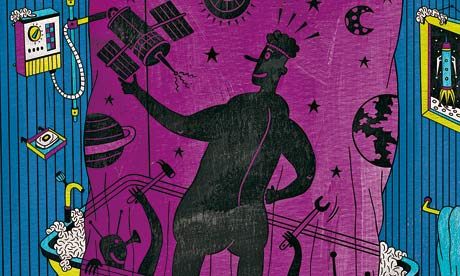
What made Leonardo da Vinci, Thomas Edison and Albert Einstein such creative geniuses? It wasn't reading books or watching YouTube talks about How To Be More Creative, that's for sure. There's a deluge of such advice, but much of it is hopelessly faulty because the thing it purports to teach is surely unteachable: if startling insights could be systematically arrived at, they wouldn't be startling. The best you can do is to create a conducive environment: put in the hours; take time to daydream; avoid mind-corroding substances such as crystal meth, and parody books based on Fifty Shades Of Grey. But what if you could program a computer to have insights? A project led by Anthony McCaffrey, a University of Massachusetts psychologist, has been focused on doing exactly that, and it's significantly less preposterous than it sounds.
McCaffrey, last featured here addressing the related matter of "functional fixedness" – the mental block that stops us seeing alternative uses for everyday objects – begins with an observation: most creative breakthroughs arise through analogy. Alexander Graham Bell modelled the telephone on the human ear. A hitch with the Hubble space telescope was fixed when a Nasa engineer taking a shower in a German hotel saw how he might borrow the design of the shower head. Enter the problem you're trying to solve, and McCaffrey's "analogy finder" software, already released in initial form, will hunt patent databases, research libraries, et cetera, for analogous solutions. He cites the example of a ski company, beset by a major problem: at high speeds, their skis vibrated, lost contact with the snow and sent skiers out of control.
The key to a solution lies in how you state the problem. You need to strip it of context and colour; more technically, McCaffrey argues, you need to reduce it to a specific form: "verb, noun-phrase, prepositional-phrases". What the ski firm really needed to do was to "reduce vibrations over 1,800 hertz". From there, it's an easier leap from one domain to another: similar vibrations, it turns out, play havoc with violins, causing sound distortion. Violin designers address this by using a metal grid; the ski designers, finding the analogy, adapted it: problem solved.
It's tempting to wonder if the first part of this approach – stating the problem with dry precision – might be helpful in realms beyond product design. Take personal dilemmas: do you really want to "save a marriage", for example, or to "maximise the chances of happiness for members of this family"? The second part – thinking in analogies – seems less broadly applicable. But it might help us avoid the flawed analogies that bedevil our efforts at problem-solving. One obvious example is thinking about the national economy as if it were a household budget. Another is the common self-help advice to "think like an entrepreneur" in domains outside business. The truth is that the problem you're trying to solve – in your love life, say, or personal finances – probably isn't analogous to those faced by entrepreneurs, so copying them won't help you on life's journey. Which, by the way, isn't really a "journey".
• The Antidote: Happiness For People Who Can't Stand Positive Thinking, by Oliver Burkeman, is published in paperback by Canongate Books at £8.99.
oliver.burkeman@theguardian.com
Follow Oliver Burkeman on tTwitter

